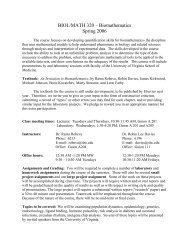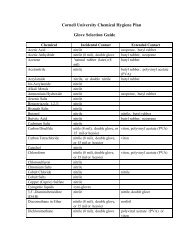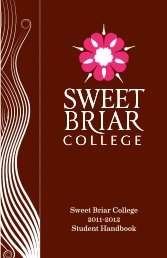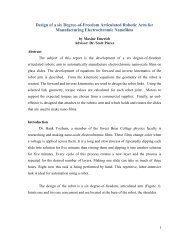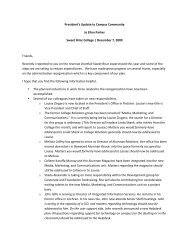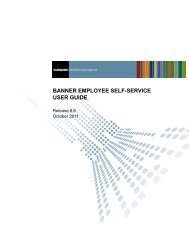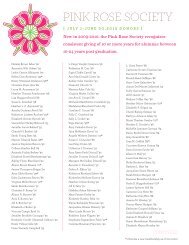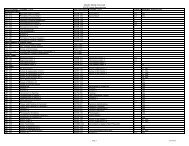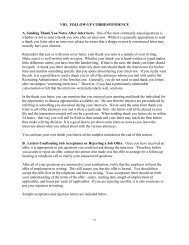Download PDF - Sweet Briar College
Download PDF - Sweet Briar College
Download PDF - Sweet Briar College
You also want an ePaper? Increase the reach of your titles
YUMPU automatically turns print PDFs into web optimized ePapers that Google loves.
“I TRY TO EAT SOMETHING THAT IF I DO GET<br />
sick, I wouldn’t mind it coming back up,” she says.<br />
Once past the odor, it’s easy to get excited by what she<br />
finds. Much of it is too small to easily identify but the<br />
discovery of three quarter-sized crabs is pay dirt. Going into<br />
the project, Grey expected the rays’ diet to consist of bigger,<br />
high-caloric prey such as clams and crabs. After examining<br />
20 or so stomachs, that’s not what she is finding.<br />
Cownose rays are those sleek kite-shaped, long-tailed<br />
fishes you often see swimming around in aquaria “touch<br />
tanks.” Seems odd, then, that life in the Chesapeake Bay is<br />
considerably more hostile for the stingrays.<br />
“I have seen these beautiful rays shot with guns and shot<br />
with arrows and had large stones and cinder blocks dropped<br />
on their heads, all because everyone assumes that they are a<br />
direct competitor that needs to die,” says Grey’s advisor John<br />
Morrissey, a marine biologist at <strong>Sweet</strong> <strong>Briar</strong>.<br />
e rays have been accused of a host of atrocities from<br />
wiping out the softshell clam fishery and plundering<br />
commercial oyster beds to destroying delicate grasses that<br />
conservationists have been at pains to re-establish in the<br />
environmentally troubled Chesapeake.<br />
e problem is they migrate into the Bay every summer<br />
by the millions. ere they both reproduce and feast —<br />
leaving behind telltale feeding craters in the sediment where<br />
they’ve searched for prey. In such numbers, and with each<br />
adult weighing 25 to 35 pounds, they do eat a lot. But what<br />
exactly are they eating?<br />
“Well, everyone in the area simply assumes that they are<br />
eating whatever is important to that person,” Morrissey says.<br />
“So commercial clammers are ‘certain’ that the rays are eating<br />
clams, and recreational crabbers are ‘certain’ that they are<br />
eating crabs, and the oystermen are ‘certain’ that they are<br />
eating oysters.<br />
“Bottom line? Everyone hates them and a grassroots<br />
campaign to exterminate them is vigorously under way.”<br />
Worse, there’s a movement afoot to establish a<br />
commercial fishery to control their numbers in the Bay—<br />
something scientists fear would endanger the migratory<br />
species and have ecological repercussions. ey reproduce<br />
slowly, there’s no reliable estimate of their actual numbers<br />
and no one knows where they go when they leave the<br />
Chesapeake in September.<br />
To take some of the heat off the beleaguered fish, Grey<br />
and Morrissey are collaborating with Doreen McVeigh ’09<br />
and her master’s thesis advisor Drew Ferrier at Hood <strong>College</strong>,<br />
to determine what it really does eat. Previous studies<br />
produced conflicting data, but one in the late 1970s<br />
concluded they eat softshell clams exclusively. It was later<br />
supported by a 1985 study. at fishery, however, no longer<br />
exists in the Bay.<br />
In the summer of 2010 Grey interned with McVeigh<br />
at St. George Island, Md. ey, along with McKenzie<br />
Grundy ’13 and Morrissey, spent several weeks trying to<br />
catch rays.<br />
Several fruitless fishing trips led them to befriend<br />
commercial fishermen, who are happy to hand over the rays<br />
that wander into their pound nets. e fieldwork taught Grey<br />
to expect things to not go as planned and to work with what’s<br />
at hand. “at’s continued on with the research I am doing<br />
now,” she says.<br />
Actually, the unpredictability in the field and lab appeals<br />
to her and she has decided to apply to marine biology<br />
graduate programs. “I was pre-vet for a while,” she said,<br />
stopping herself. “at’s a lie, I was pre-vet since I was five.”<br />
Under Morrissey’s guidance in the lab, Grey is working<br />
with frozen specimens this semester and she will report on<br />
her findings in late November. ey may not be ready to<br />
draw conclusions by then; much depends on how many<br />
samples Grey is able to process. So far, however, the diversity<br />
of worms, fishes and nearly microscopic bivalves contradicts<br />
earlier studies suggesting their diet is highly specialized. at<br />
could go either way for the cownose ray.<br />
“Frankly, I would be shocked if they don’t eat something<br />
that is of commercial value,” Morrissey says. “But if we can<br />
show that they are still very narrow in their prey selection,<br />
then maybe we can cause, for example, oystermen to<br />
continue to despise them while everyone else leaves them<br />
alone.<br />
“Would the rays get to swim around with fewer arrows<br />
in their backs after that?”<br />
22<br />
SWEET BRIAR MAGAZINE | SBC.EDU





